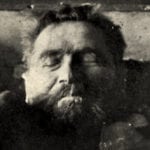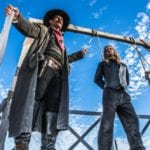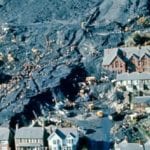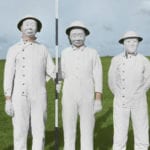 Humans
Humans  Humans
Humans  Movies and TV
Movies and TV The 10 Most Heartwarming Moments in Pixar Films
 Travel
Travel Top 10 Religious Architectural Marvels
 Creepy
Creepy 10 Haunted Places in Alabama
 History
History Top 10 Tragic Facts about England’s 9 Days Queen
 Food
Food 10 Weird Foods Inspired by Your Favorite Movies
 Religion
Religion 10 Mind-Blowing Claims and Messages Hidden in the Bible Code
 Facts
Facts 10 Things You Never Knew about the History of Gambling
 Weird Stuff
Weird Stuff 10 Cool and Creepy Facts about Collecting Tears
 Humans
Humans The Ten Most Lethal Gunslingers of the Old West
 Humans
Humans Ten Historic Men Who Deserve Way More Credit Than They Got
 Movies and TV
Movies and TV The 10 Most Heartwarming Moments in Pixar Films
 Travel
Travel Top 10 Religious Architectural Marvels
Who's Behind Listverse?

Jamie Frater
Head Editor
Jamie founded Listverse due to an insatiable desire to share fascinating, obscure, and bizarre facts. He has been a guest speaker on numerous national radio and television stations and is a five time published author.
More About Us Creepy
Creepy 10 Haunted Places in Alabama
 History
History Top 10 Tragic Facts about England’s 9 Days Queen
 Food
Food 10 Weird Foods Inspired by Your Favorite Movies
 Religion
Religion 10 Mind-Blowing Claims and Messages Hidden in the Bible Code
 Facts
Facts 10 Things You Never Knew about the History of Gambling
 Weird Stuff
Weird Stuff 10 Cool and Creepy Facts about Collecting Tears
 Humans
Humans The Ten Most Lethal Gunslingers of the Old West
10 Fiendish Stories About Asia’s Forgotten Dictator
Ferdinand Marcos was the dictator of the Philippines for over two decades. His 21-year reign was marked with a vigorous campaign against communists inland and abroad, dark plots sanctioned by the CIA and US presidents, and martial law—under which repression, imprisonment, torture, and executions became the norm. Here are 10 stories about “Macoy,” his family and his henchmen, and their downright disturbing antics.
10 A Boy Genius On Death Row

Marcos was said to be a genius with a photographic memory, able at a young age to recite the Constitution and even entire speeches dictated to him. He studied law at the University of the Philippines, topping the 1939 Bar Examinations with a score of 92.35 percent. When he was accused of cheating, he had to retake the exam—and got a perfect score of 100 percent (though whether he really scored that or just cheated again is unclear). As impressive as these supposed accomplishments are, Marcos actually studied for the bar exams while incarcerated for murder.
On September 20, 1935, politician Julio Nalundasan was gunned down in his own home. Nalundasan had defeated Ferdinand’s father Mariano in the recent election, so the Marcos clan allegedly conspired to kill him, with Ferdinand becoming the triggerman. The family hoped that the courts would be lenient with the young man, seemingly forgetting that he had just celebrated his 18th birthday.
Ferdinand Marcos was found guilty of premeditated murder and sentenced to death. The Marcos clan appealed to the Supreme Court, and Ferdinand vigorously prepared his own case while studying for the bar. On October 22, 1940, Ferdinand Marcos and his associates were acquitted of all crimes save for contempt. He had wormed his way out of the electric chair.
9 Exaggerated Wartime Heroism

As Japanese bombs rained down on Pearl Harbor, death and destruction hit the Philippines as well. The forces of Imperial Japan were quick to assault American strongholds in the country, leading to its capitulation a few months later. Despite the disasters experienced by Filipinos and Americans, a few men continued to fight on. One of them was Ferdinand Marcos.
Marcos is said to have received 27 or more medals for valor during the war while leading an elite guerrilla unit, the Maharlika (“noble warriors”). Marcos’s 9,200 men struck fear into the hearts of the unwary Japanese, taking them out when least expected then disappearing under the cover of night. He was also known to have “single-handedly delayed the Fall of Bataan” by “at least three months.” Such a valiant man truly deserved praise—except most of these exploits were fabricated.
Due to the chaos of the time, fact often mixed with fiction. Marcos and his supporters were able to drum up story after story, and he would regale investors, politicians, and voters with tales of experiences that never truly happened.
According to the Pentagon, Marcos did receive medals—around three—for his conduct during the early days of World War II. As for his guerrilla campaign, US Army officers deemed Marcos’s boasts “fraudulent” and “absurd” because “no such guerrilla unit ever existed in the first place.”
8 Questionable Projects
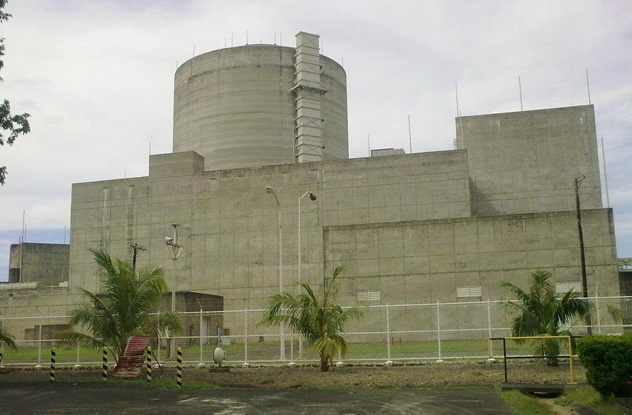
Marcos implemented vast infrastructural projects, building roads, schools, and health centers. He also had a company construct the Bataan Nuclear Power Plant, the first of its kind in the country. The facility, which overlooked the path taken by those who were victims of the Death March during the war, became a site for wanton graft and corruption. At least $2.2 billion was spent on a dilapidated facility with faulty machinery, while kickbacks went to Marcos and his henchmen. The debt from the facility was only fully paid in 2007.
Another acquisition was the island of Calauit. Hundreds of families were evicted to make way for animals—giraffes, antelopes, and other creatures native to Kenya. The island became a safari, a wildlife preserve far from the urban jungle of Manila. Supporters praised Marcos for his advocacy, though it was wildly believed that he went through all that effort just to give his only son, Ferdinand Jr., his own hunting grounds.
The lavish Manila Film Center, meanwhile, was built to create the “illusion of wealth and grandeur.” The building was modeled after the Parthenon, and the first event it would host, the Manila Film Festival, aimed to rival Cannes. Then on November 17, 1981, the upper floors’ scaffolding collapsed, killing as many as 170 people. These were poor workers from the provinces, and the media was under the government’s control, so the story was largely ignored at the time. An urban legend persists that dozens more trapped in the rubble were expediently buried in concrete to meet the project’s deadline. The building, a testament to Marcos’s folly, now hosts late-night comedy shows headlined by transvestites—a long way from being Cannes’s rival.
7 Lover Boy
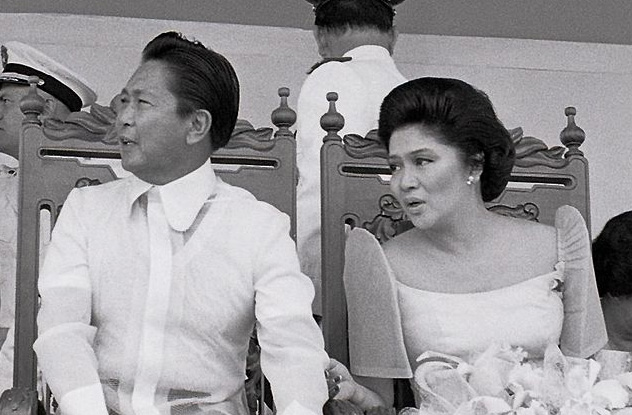
Whether it was dancing with LBJ or being beloved by China and the Soviet Union, First Lady Imelda Marcos projected an aura that propelled Ferdinand’s career. Perhaps that’s why he let her have what she wanted, from outrageously expensive jewelry to paintings by Michelangelo and Van Gogh to her infamous collection of over 1,000 pairs of designer shoes, the majority of which were found destroyed by termites after decades in storage.
But Imelda was not the only woman in Ferdinand’s life. His fling with Hollywood starlet Dovie Beams lasted from 1968 to 1970. Beams was known to have secretly followed Marcos as part of his entourage, calling him “Freddie” while the dictator called her “Big Eyes.” She often spoke in public about her affair with the president, including how Marcos would write poetry and serenade her.
She allegedly recorded a tape of Marcos, capturing the president’s pubic hair on camera. Imelda was so angry that she ordered a hit on Dovie Beams, forcing her to flee the country.
6 Wacky Schemes To Stay In Power
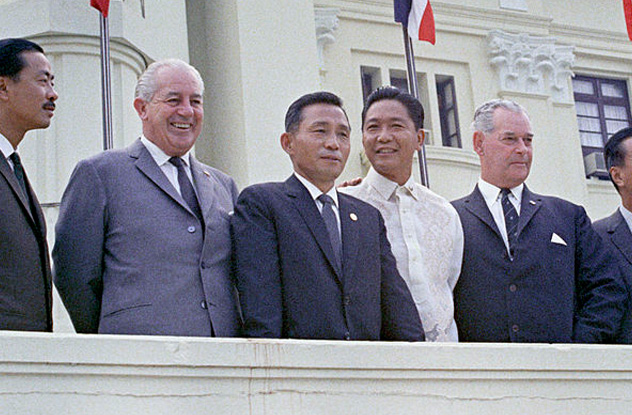
Under the Philippine Constitution at the time, no president could rule for more than eight consecutive years. Each term lasted four years, and reelection was allowed only once. Marcos toyed with various ideas on how he was to stay in power beyond this length.
By the early 1970s, in his second term, he considered having Imelda run for the presidency. But Imelda, despite her charms, was unpopular in the polls (as was the idea of a female president). So he maneuvered to change the Philippine government from an American-style presidential system to one similar to the British parliament. Marcos would run as a representative of Congress and then be elected as Prime Minister for life.
Several restrictions within the existing constitution prevented Marcos from completing his schemes. Then, on August 21, 1971, bombs exploded at a political rally. The alleged perpetrator was a policeman who was never seen or heard from again. The bombing let Marcos declare martial law and gain emergency powers, which extended his term in office and led to the creation of a new constitution to his own liking.
5 A Self-Proclaimed Savior Against Communism
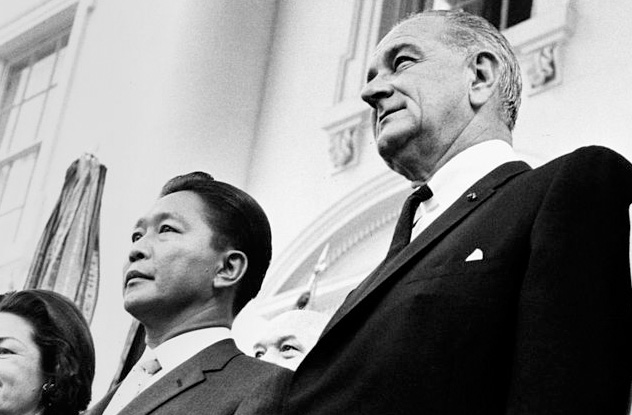
Marcos and military planners recruited 200 Muslims for a clandestine operation codenamed “Merdeka,” designed to assault and destabilize the provincial government of Sabah, Malaysia. Should the mission succeed, government forces would seize the territory for the Philippines. When the recruits found out that they would be fighting against their Muslim brothers in Sabah and also natives from their villages, they backed out. On March 18, 1968, government troops pulled the plug on the mission and gunned down the recruits. Only one survivor lived to tell the tale.
With regards to the Vietnam War that was raging at the time, prior to his election as president in 1965, Marcos staunchly opposed the Philippines participating in any capacity. But he changed his mind—the United States sent over a lot of money in economic packages, and the Johnson administration directly paid him off with $39 million in exchange for sending 10 battalions to the front lines.
4 The Rolex Twelve And US Involvement

The most trusted in Marcos’s cabal were known as “The Rolex Twelve” because each man received the most expensive golden Rolex watches available. Within this circle was an inner circle, “The Omega Five”—these men got Omega watches. The son of Defense Minister Juan Ponce Enrile (one of the Rolex Twelve) was twice believed to have slain innocent men, one a popular actor. No charges were filed out of fear of crossing Marcos and his cohorts.
How could all these things have happened to a close ally of the United States? The US understood the strategic importance of the Philippines, and they were willing to tolerate corruption to be on good terms with the dictator.
Before martial law was even declared, the CIA informed President Nixon and Henry Kissinger that Marcos’s plans were coming to fruition. According to reports, Nixon was “bored by the news,” and a message was conveyed to Marcos—Washington would back him.
3 Stealing Yamashita’s Treasure
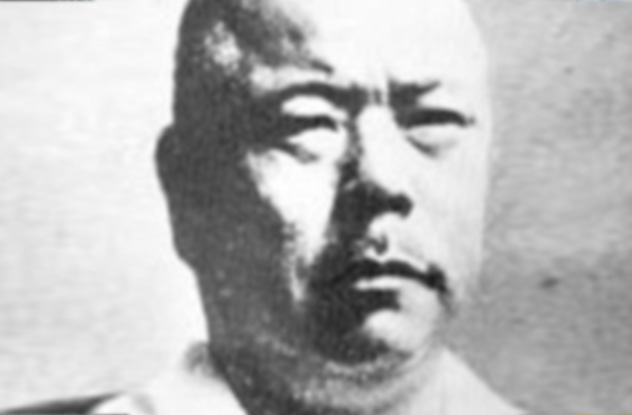
During World War II, the Japanese plundered the wealth of Asian territories under their occupation. The hoard attained legendary status and became rumored to be hidden deep in the Philippine interior by General Tomoyuki Yamashita. The treasure included precious gems and jewels, rare metals, thousands of tons of gold bars, and a gigantic gold-encrusted statue of Buddha—collectively known as the “Yamashita Treasure.”
On January 24, 1971, the golden Buddha statue and many of the gold bars were allegedly unearthed by locksmith Rogelio Roxas from underneath a hospital. Upon hearing of the news, the eyes of Marcos and his cohorts twinkled with greed. Marcos’s goons seized the treasure, and Roxas was imprisoned for several years.
Accounts vary as to what had happened to the treasure and to the man. Witnesses said that Roxas was suddenly beaten up and bound. Others say Marcos switched the original golden statue with a fake. Theories abound that Roxas was murdered shortly before a trial was to take place.
Roxas’s family vehemently contested the rights to the treasure. A legal battle has waged for decades, extending to Hawaii (upon Marcos’s exile) and even to Switzerland (where Marcos allegedly had bank accounts).
2 Trolling The Beatles
In July 1966, The Beatles came to Manila. One story says that the concert promoter promised the First Family that The Beatles would attend a luncheon, but manager Brian Epstein was not told of the arrangement, so the four went boating in the Manila Bay instead. Another source says that Epstein received the invitation but politely declined. Either way, the Marcos family took it as a huge insult. Despite the huge stardom of The Beatles, the Marcoses took it upon themselves to make their remaining hours in the Philippines as miserable as possible.
Radio and TV stations broadcast the snub like a crime committed against society. Their security escort was removed, and the hotel porters and drivers suddenly disappeared—they had to take cabs. When they reached the airport, the escalators were turned off, and they were forced to carry their heavy equipment up flights of stairs. Their flight was purposefully delayed, and customs officials harassed them.
When they made it near the plane, they had to go through protesters who kicked, punched, and spat at their entourage. Brian Epstein was kicked in the groin; roadies were kicked in the ribs until they bled. Bodyguards shielded the performers’ backs to protect them in case anyone opened fire. The Manila Times crafted an exaggerated story of how events unfolded: “Ringo Starr was floored by an uppercut, crawling away as a mob viciously kicked him. George Harrison and John Lennon received kicks and blows as they ran to the customs area. Paul McCartney, however, was relatively unhurt.”
1 A Last-Ditch Attempt To Stay In Power

Ninoy Aquino’s assassination in 1983 led to an outpouring of support for his widow Cory. Marcos, left with a grim future, meekly sought advice from the United States.
A relatively untold story is the friendship between Marcos, Ronald Reagan, and George H.W. Bush. Bush was known to have hailed Marcos for his “adherence to democratic principles.” Marcos was also rumored to have given Reagan funds from the Philippine treasury to finance his 1984 campaign. An even darker conspiracy is that Marcos aided Reagan and Bush discreetly in their attempts to sabotage Jimmy Carter’s negotiation attempts during the Iran Hostage Crisis.
As protesters crowded the streets of the capital, Marcos met with Reagan’s men. They outlined five conditions for the ruler to remain in power, including removing his wife from any governmental position. This plan failed, as did one for Marcos and Cory to share power.
Faced with no other choice, US Senator Paul Laxalt told Marcos “cut and cut clean.” Reagan’s aides were ready to take the dictator, his family, and his closest companions to exile in the United States. It was in the beautiful islands of Hawaii where Marcos would die from lupus on September 28, 1989.
+ His Lasting Legacy

To immortalize himself, Marcos ordered the construction of a huge concrete bust overlooking a mountain pass. After he was ousted from power, it was blown to smithereens. The Ibalois, an indigenous tribe forcefully evicted to have the monument constructed in that area, slaughtered a water buffalo and bathed the statue with its blood to exorcise the evil spirit.
Marcos’s remains lie in a mummified state. Some say he should be buried in the country’s Heroes’ Cemetery due to his supposed heroics during World War II.
The Marcos family remains powerful. His wife was elected congresswoman thrice. His daughter was a congresswoman and governor as well. His only son, who got his own safari island, won a seat in the Senate, placing seventh among several candidates. His extended family and past cohorts are influential in business and entertainment circles as well.
The Rolex Twelve still linger in Philippine politics. In fact, Marcos’s former defense minister was involved in a plunder case in 2014 where he allegedly amassed over 172 million pesos in kickbacks.
Jo is a Filipino. Sometimes he wonders if his countrymen are the most forgiving people in the world, or the most forgetful. What do you think? Let him know via email or in the comments section.


